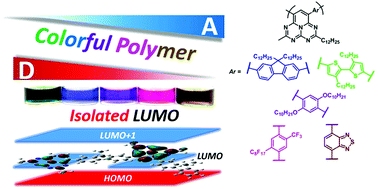Color tuning of alternating conjugated polymers composed of pentaazaphenalene by modulating their unique electronic structures involving isolated-LUMOs†
Abstract
Synthesis of a series of alternating copolymers composed of pentaazaphenalene (5AP) with several kinds of comonomer units was performed via Suzuki–Miyaura coupling reactions. Systematic absorption shift was introduced in a successful manner by changing the electron-donating and electron-accepting abilities of the comonomer units, leading to remarkable color change of the polymer solution. In order to elucidate the electronic structures of these polymers, electrochemical measurement and theoretical analysis were performed. In particular, it was suggested that the highest occupied molecular orbital (HOMO) conjugated throughout the polymer chain and the lowest unoccupied MO (LUMO), or its equivalent, localized at the 5AP fragment, play an important role in absorption in the visible region. To the best of our knowledge, this is the first report on the unique electronic structures of polymer main-chains having simultaneously various conjugation motifs.


 Please wait while we load your content...
Please wait while we load your content...